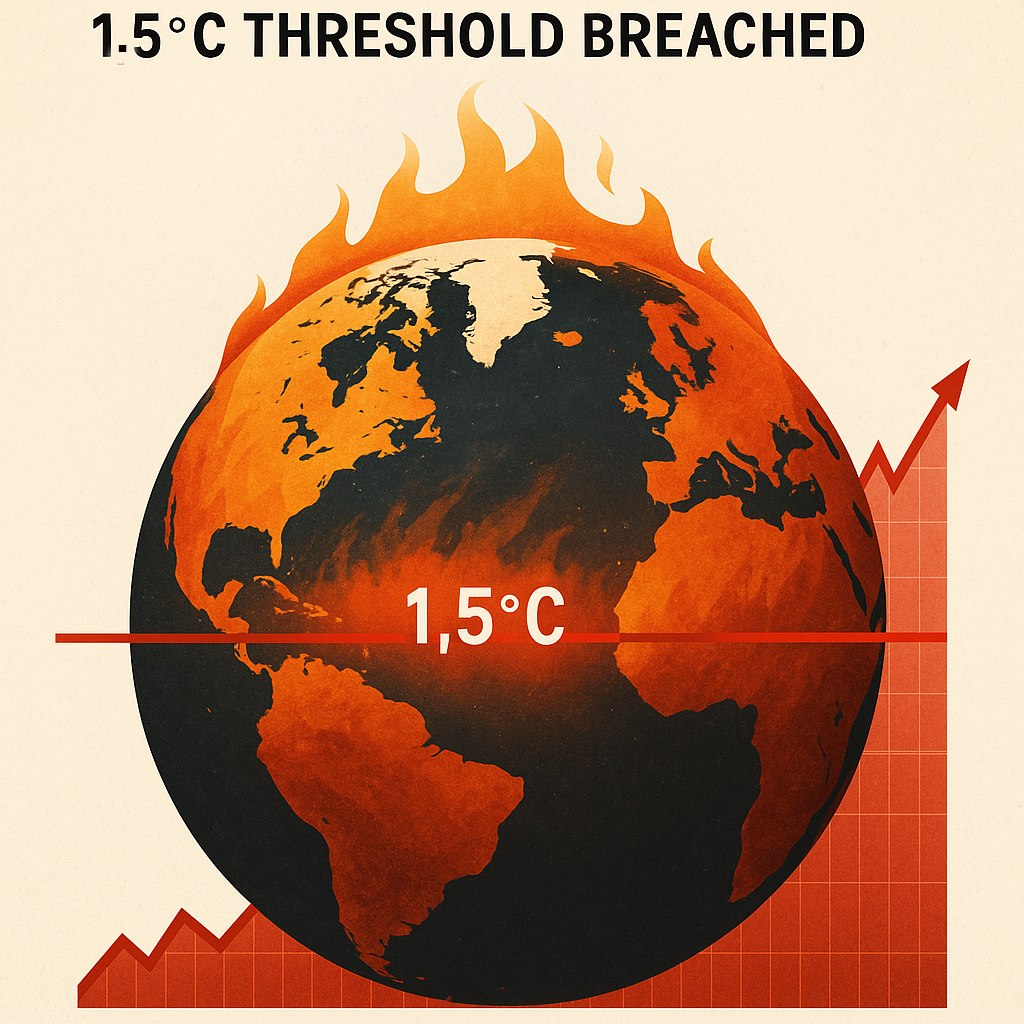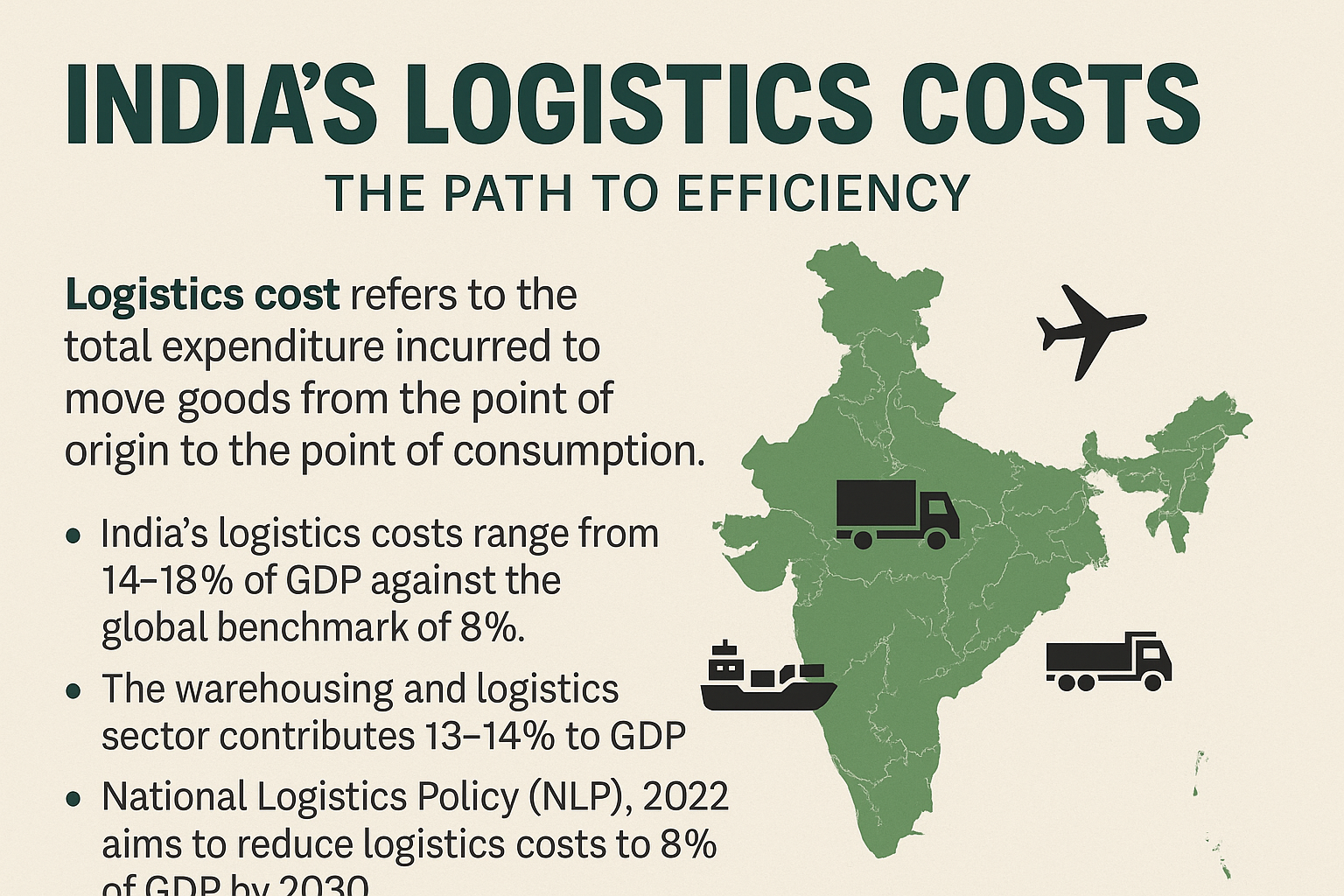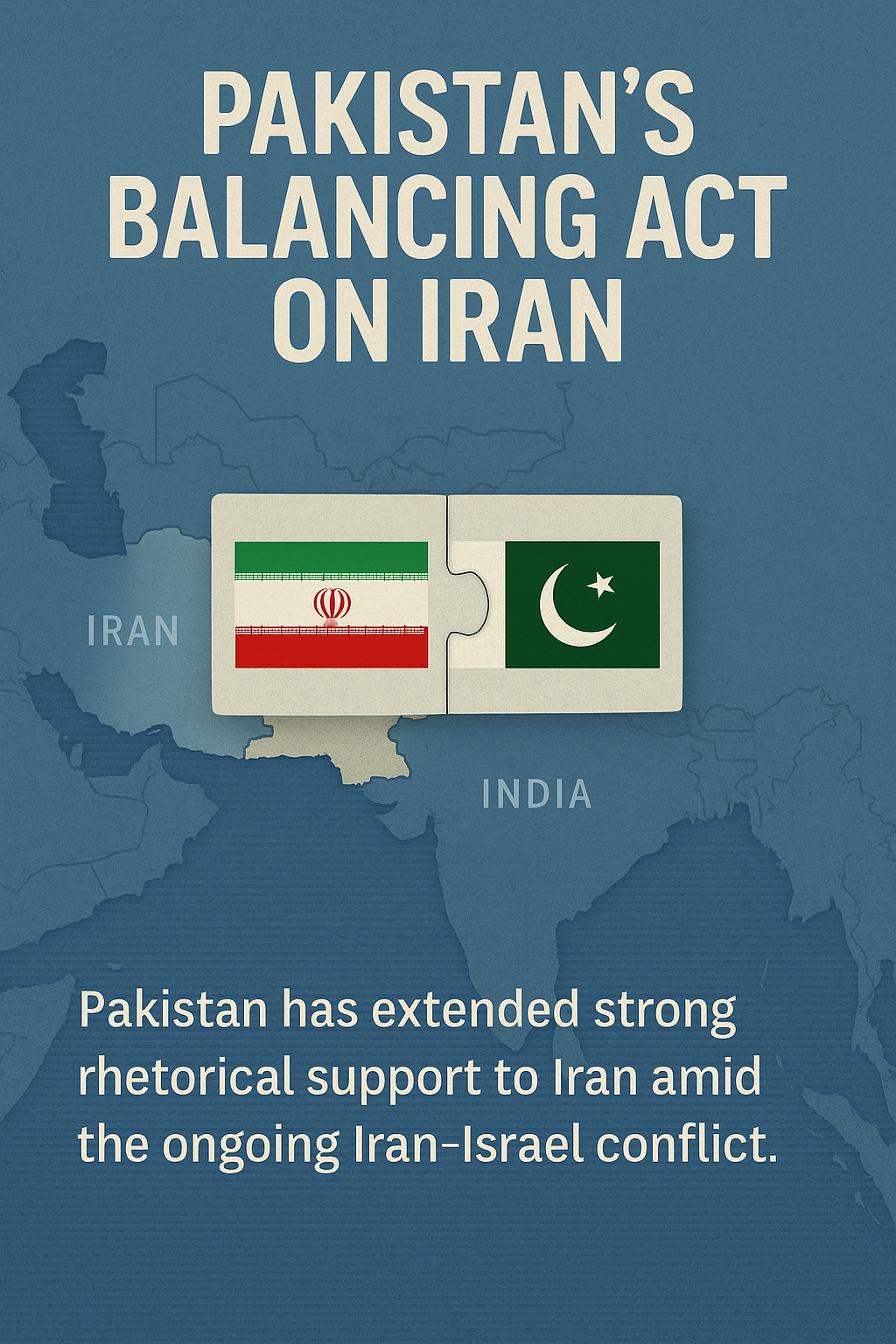
🧭June 2, 2025 Post 1: One Degree Too Far: Earth Edges Toward Climate Tipping Point | High Quality Mains Essay | Prelims MCQs
One Degree Too Far: Earth Edges Toward Climate Tipping Point

GLOBAL REPORT —
Post Date: June 2, 2025
Thematic Focus: GS3 / Environment and Ecology
🪷 Intro Whisper
The world just crossed a fragile threshold — and may not return the same. As temperatures soar and the Arctic warms thrice as fast, humanity stands at the brink of irreversible change. What once seemed a distant planetary warning is now a near-term global reality.
🔍 Key Highlights
- 2024 Record Heat:
2024 was the hottest year on record, and the first to breach 1.5°C above pre-industrial levels (1850–1900). - 2025–2029 Climate Forecast (WMO):
• 70% chance that the 5-year average will exceed the 1.5°C warming mark.
• 86% probability that at least one year will breach 1.5°C again.
• 80% likelihood of breaking 2024’s heat record.
• 1% chance of crossing 2°C temporarily. - Regional Outlook:
• South Asia: Continued wetter-than-usual trend; above-normal monsoon expected in 2025.
• Arctic: Expected warming of ~2.4°C in winters — 3.5x faster than global average.
• Sea Ice Loss: Barents Sea, Bering Sea, Sea of Okhotsk at risk.
• Drying Regions: Amazon Basin
• Wetter Zones: Sahel, Alaska, Northern Europe, Siberia - India Focus:
India saw above-average monsoon in 4 of the last 5 years; IMD predicts a strong monsoon for 2025.
🧭 Concept Explainer: The 1.5°C Threshold
- The 1.5°C target under the Paris Agreement is a goal, not a legal limit.
- A single year crossing 1.5°C ≠ permanent breach — sustained warming over 2–3 decades defines a true breach.
- Long-term warming can lead to ecosystem collapse, sea-level rise, extreme events, and irreversible feedback loops.
🌍 The Paris Agreement and COP30
- Signed in 2015 (COP21) to limit warming below 2°C, with efforts to keep it below 1.5°C.
- Based on Nationally Determined Contributions (NDCs) — voluntary climate action goals by nations.
- All parties must submit updated NDCs every 5 years.
- 180 of 195 UNFCCC countries are yet to submit NDCs for 2031–2035 ahead of COP30.
🌐 About WMO
- World Meteorological Organization (WMO): UN specialized agency for climate and meteorology.
- Established: 1950
- HQ: Geneva
- Member States: 193
- Supreme body: World Meteorological Congress
📚 GS Paper Mapping
- GS Paper 3 – Environment
→ Climate Change and Agreements
→ Global Warming & International Reports
→ India’s Climate Commitments
→ Institutions (WMO, UNFCCC, COP)
🌱 A Thought Spark — by IAS Monk
“The Earth doesn’t shout when it breaks — it whispers in heatwaves, disappears in ice, and cries through floods. We are not running out of time. We are running out of excuses.”
High Quality Mains Essay For Practice :
Word Limit 1000-1200
Global Warming: The Fire Beneath Our Future
Introduction
Once considered a slow-moving environmental concern, global warming has now emerged as the defining challenge of the 21st century. Temperatures are rising, glaciers are retreating, sea levels are surging, and weather patterns are becoming increasingly unpredictable. The World Meteorological Organization’s (WMO) recent forecast — predicting a likely breach of the 1.5°C global temperature threshold within the next five years — has converted caution into alarm. More than an environmental issue, global warming has become a geopolitical, economic, health, and ethical crisis that affects every nation, every community, and every ecosystem.
Understanding Global Warming
Global warming refers to the long-term rise in Earth’s average surface temperature due to the accumulation of greenhouse gases (GHGs) in the atmosphere. These gases — including carbon dioxide (CO₂), methane (CH₄), nitrous oxide (N₂O), and water vapor — trap heat from the sun, creating a “greenhouse effect.” While this effect is necessary for sustaining life on Earth, its intensification due to human activity has disrupted Earth’s energy balance.
Key drivers of global warming include:
- Burning of fossil fuels for electricity, transport, and industry
- Deforestation and land degradation
- Agricultural emissions, particularly methane from livestock and rice paddies
- Waste generation and improper disposal
Since the Industrial Revolution, global temperatures have risen by over 1.1°C. The latest climate projections warn that we are rapidly approaching the 1.5°C threshold, considered the danger line by climate scientists.
The 1.5°C Threshold: Why It Matters
The Paris Agreement (2015) sought to limit global warming to well below 2°C, ideally to 1.5°C above pre-industrial levels. The 1.5°C limit is not arbitrary — it’s a scientific tipping point:
- At 1.5°C: Coral reefs decline by 70–90%, ice-free Arctic summers become more frequent, heatwaves intensify, and many vulnerable species begin to vanish.
- At 2°C: These effects double or triple. Coastal flooding, crop failures, mass migration, and biodiversity loss accelerate drastically.
What’s worrying is that even a single-year breach of the 1.5°C threshold, as observed in 2024, increases the risk of long-term overshoot if corrective action is delayed.
Impacts of Global Warming: A Planet in Peril
- Melting Ice and Rising Seas
- Polar ice caps, glaciers, and snowpacks are melting rapidly.
- Sea levels have already risen over 20 cm in the last century, and projections suggest up to 1 metre rise by 2100, threatening low-lying nations and coastal megacities like Mumbai, Dhaka, and Jakarta.
- Extreme Weather Events
- More frequent and intense heatwaves, floods, droughts, and cyclones.
- The 2023 European summer saw over 60,000 heatwave deaths — a grim preview of the future.
- Biodiversity Loss and Ecosystem Collapse
- Many species are unable to adapt to changing habitats.
- Coral reefs — critical to marine biodiversity and coastal protection — are bleaching en masse.
- Food and Water Insecurity
- Rising temperatures affect crop yields and nutritional quality.
- Glacial melt and erratic monsoons disrupt freshwater availability, especially in the Himalayan and Indo-Gangetic plains.
- Public Health Crisis
- Increase in vector-borne diseases (e.g., malaria, dengue), respiratory issues due to pollution, and heatstroke-related deaths.
- Mental health stress due to displacement, loss, and anxiety over future security.
Global Inequality and Climate Justice
Climate change is not an equal-opportunity crisis. Developing nations, which have contributed the least to historical emissions, are among the most vulnerable:
- Small Island Developing States (SIDS) face existential threats from sea-level rise.
- Africa and South Asia face harsher droughts and food shortages.
- Marginalized communities, indigenous peoples, and women often lack the resources to adapt.
Meanwhile, the top 1% of the global population contributes disproportionately to carbon emissions. This asymmetry has given rise to calls for climate justice, demanding that polluters bear the cost of climate resilience and transition.
India and Global Warming: A Double Challenge
India finds itself at the crossroads of development and decarbonization:
- It is the third-largest emitter of greenhouse gases but also home to 17% of the world’s population, many of whom still lack access to reliable energy and basic infrastructure.
- India has shown climate leadership through commitments like achieving Net Zero by 2070, scaling solar energy (100 GW+ installed), and pioneering International Solar Alliance (ISA).
- Yet, India faces rising climate vulnerabilities — floods in Kerala, droughts in Bundelkhand, Himalayan glacial lake bursts, and record-breaking heatwaves in Delhi.
The future of India’s growth lies in green growth: climate-resilient agriculture, electric mobility, green hydrogen, and sustainable urbanization.
Global Climate Governance: Gaps and Hopes
Despite the Paris Agreement, current global efforts are falling short:
- Nationally Determined Contributions (NDCs) remain inadequate to limit warming to 1.5°C.
- Climate finance — the promised $100 billion annually from developed countries — has not been fully delivered.
- Carbon markets, while promising, suffer from issues of double counting and greenwashing.
However, there are glimmers of hope:
- COP28 (2023) saw agreement on a Loss and Damage Fund to help vulnerable countries.
- Youth climate movements, climate litigation, and civil society activism are shifting the global narrative.
- Corporate accountability and ESG mandates are slowly greening the private sector.
Solutions: Bending the Emissions Curve
- Energy Transition
- Move from fossil fuels to renewable energy: solar, wind, hydro, and nuclear.
- Electrify transport systems and promote energy efficiency.
- Climate-Resilient Agriculture
- Crop diversification, agroforestry, climate-smart irrigation, and precision farming.
- Reduce methane and nitrous oxide emissions from livestock and fertilisers.
- Nature-Based Solutions
- Afforestation, mangrove restoration, wetland preservation.
- Protecting biodiversity helps stabilize climate systems.
- Urban Adaptation
- Build green cities with efficient public transport, cool roofs, and sponge landscapes to absorb floods.
- Policy and Behavioral Change
- Carbon pricing, green taxes, and subsidies for sustainable practices.
- Promote sustainable lifestyles — reduce meat consumption, single-use plastics, and energy wastage.
A Philosophical Reflection: The Planet as a Commons
Climate change also compels us to rethink our relationship with nature. The Earth is not a warehouse of resources but a living commons — something we all inherit, share, and must sustain.
Indigenous worldviews, Gandhian minimalism, and modern ecological ethics all remind us that we are not owners of the planet, but stewards.
If we act now, with urgency and compassion, we can ensure that development doesn’t come at the cost of survival.
Conclusion
Global warming is no longer a future threat — it is a current crisis. The science is clear, the warnings are louder than ever, and the solutions are within reach. What remains is collective will. Every fraction of a degree matters. Every year counts. And every action, big or small, shapes the kind of world we leave behind.
“We do not inherit the Earth from our ancestors — we borrow it from our children.”
Let us return it with fewer scars and greater hope.
Target IAS-26: Daily MCQs :
📌 Prelims Practice MCQs
Topic: Global Warming
MCQ 1 – Type 1: How many of the above statements are correct?
Consider the following statements about the consequences of global warming:
1. Sea-level rise has already exceeded 50 cm over the last century.
2. Arctic warming is occurring faster than the global average.
3. Coral reefs are vulnerable even at 1.5°C warming.
4. The frequency of extreme weather events has increased due to rising global temperatures.
How many of the above statements are correct?
A) Only two
B) Only three
C) All four
D) Only one
🌀 Didn’t get it? Click here (▸) for the Correct Answer & Explanation
✅ Correct Answer: B) Only three
🧠 Explanation:
•1) ❌ False – Sea level rise is currently about 20–25 cm, not 50 cm.
•2) ✅ True – The Arctic is warming more than 3 times faster than the global average.
•3) ✅ True – Even at 1.5°C, coral bleaching becomes widespread.
•4) ✅ True – Heatwaves, floods, and cyclones have intensified due to rising temperatures.
MCQ 2 – Type 2: Two Statements Based
Consider the following statements:
1. The Paris Agreement mandates all countries to legally cap global warming below 1.5°C.
2. A single-year breach of 1.5°C does not constitute a permanent violation of the Paris target.
Which of the above statements is/are correct?
A) Only 1 is correct
B) Only 2 is correct
C) Both are correct
D) Neither is correct
🌀 Didn’t get it? Click here (▸) for the Correct Answer & Explanation
✅ Correct Answer: B) Only 2 is correct
🧠 Explanation:
•1) ❌ False – The 1.5°C goal is aspirational, not legally binding.
•2) ✅ True – Only sustained long-term warming (over 20–30 years) indicates a permanent breach.
MCQ 3 – Type 3: Which of the statements is/are correct?
Which of the following are recognized greenhouse gases contributing to global warming?
1. Carbon Dioxide (CO₂)
2. Methane (CH₄)
3. Nitrous Oxide (N₂O)
4. Sulphur Dioxide (SO₂)
Select the correct code:
A) 1, 2 and 3 only
B) 1 and 2 only
C) 1, 2 and 4 only
D) All four
🌀 Didn’t get it? Click here (▸) for the Correct Answer & Explanation
✅ Correct Answer: A) 1, 2 and 3 only
🧠 Explanation:
•1) ✅ CO₂ is the major long-lived greenhouse gas.
•2) ✅ CH₄ is a potent short-lived climate pollutant.
•3) ✅ N₂O is a major greenhouse gas from agriculture.
•4) ❌ SO₂ causes acid rain but has a cooling effect, not a greenhouse effect.
MCQ 4 – Type 4: Direct Fact
Which organization publishes the ‘Global Annual to Decadal Climate Update’?
A) UNEP
B) UNFCCC
C) IPCC
D) WMO
🌀 Didn’t get it? Click here (▸) for the Correct Answer & Explanation.
✅ Correct Answer: D) WMO
🧠 Explanation:
• The World Meteorological Organization (WMO), a UN agency, publishes annual and decadal climate updates.
• IPCC provides Assessment Reports; UNFCCC hosts COP meetings; UNEP supports environmental action.


















